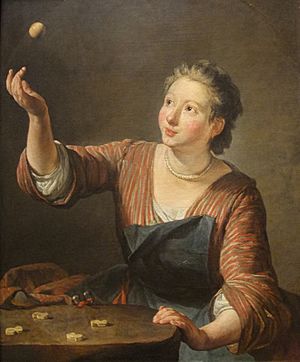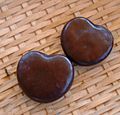Jackstones facts for kids
Knucklebones also known as hucklebones, dibs, dibstones, jackstones, chuckstones or five-stones, is a game of very ancient origin, the origin of knucklebones is closely connected with that of dice, of which it is probably a primitive form, and is doubtless Asiatic.
Played with five small objects, originally the "knucklebones" (a bone in the ankle, or hock) of a sheep, which are thrown up and caught in various ways. Modern knucklebones are usually made of metal or plastic. The winner is the first player to successfully complete a prescribed series of throws, which, while of the same general character, differ widely in detail. The simplest consists in tossing up one stone, the jack, and picking up one or more from the table while it is in the air; and so on until all five stones have been picked up. Another consists in tossing up first one stone, then two, then three and so on, and catching them on the back of the hand. Different throws have received distinctive names.
Also there are several rules;
- The player is out if they touch any stones that they were not supposed to touch.
- The player is out if they do not catch the stone in the air.
- The player is out if they do not catch all the stones from the back of their hand in the air.
If a player is out, the next person (or team) gets the turn.
The modern game
In modern play, the player attempts a series of challenges. The official rules include:
- Over hand ones, twos, threes, fours—first "jockey" then eliminate all you have caught except one. Throw this one up and whilst it is in the air quickly pick one (two, three, or four) up off the ground, and then catch the one you threw up. Repeat with remaining knucklebones. You are able to sweep the knucklebones prior to picking them up.
- Scatter ones, twos, threes, fours—Scatter all five, select and pick up one, throw it up and without "sweeping" proceed as above.
- Dumps—hold five knucklebones in the palm, then dump them in a heap on the ground. Select one which you must take away without disturbing any others. Throw this one up, pick up other four, and catch the first one.
- Overhand scatter ones, twos, threes, fours—first "jockey" then proceed to scatter remaining knucklebones.
- Clicks—first "jockey" then proceeded as with over hand ones. When catching the one you threw up the knucklebones must click.
- No click—same as above but knucklebones must not click
- Little jingles—first "jockey", continue as over-hand ones, but keep all jacks caught in your hand at all times (including those caught while jockeying).
- Big jingles—same as above but all jacks must be thrown up each time.
- Juggles—First "jockey". If you say catch one, you throw the three in the air and whilst they are in the air pick up another, thrown that second one up, then catch the first, then catch the second. Proceed until all the jacks have been completed.
- Horse in the stable—First "jockey". Then put the tips of your five fingers of one hand on the ground, so as to make four arches. If, in "jockey" you catch say two, you put one in the 'stable' formed by your hand. Throw the other one up and whilst it is up 'sweep' another jack through one of the arches so that it stays in the stable. You can 'sweep' as many times as you like. Proceed until all 4 are stabled (each jack MUST go through a different arch!) When the 4 are in the stable take the hand away throw the fifth jack in the air and whilst it is up pick up the four and catch the fifth.
- Through the arch—As above, but only make one arch with the thumb and forefinger, and allow only one 'sweep' to get each jack through.
- Over the line—First "jockey". Place your (left)hand down on the ground. Put all the jacks caught except one, on the left side of the hand. Throw your jack up in the air and whilst it is up quickly move a jack from the right to the left hand side of the hand. Do this until all four jacks are on the left side and try and keep them together.... There must be no sweeping. When the four jacks are in the position to throw the fifth up and pick up the other four and catch the fifth.
- Over the jump—as above except your put you hand vertically on its edge instead of on the ground so it makes it harder :)
- Thread the needle—Same as above except the jacks have to be dropped through a circle made by the thumb and forefinger that is held about 8 inches from the ground. Once all have gone through—pick them up.
- Eggs in the basket—Same as above except the your hand is cupped palm up to form the basket, the jacks have to be placed in the "basket" without clicking, as this will break the eggs
- Catching flies—As 'scatter ones' but the catch must be done with a quick snatching downward movement making it much harder than the ordinary system of catching with palms upwards.
Images for kids
-
A collection of jacks within the permanent collection of The Children's Museum of Indianapolis
-
An orthostat depicting people playing knucklebones from Carchemish (c. 8th century BC)
-
Plastic modern gonggi pebbles from South Korea
-
Children in Nepal playing astragaloi
See also
 In Spanish: Juego de las tabas para niños
In Spanish: Juego de las tabas para niños










